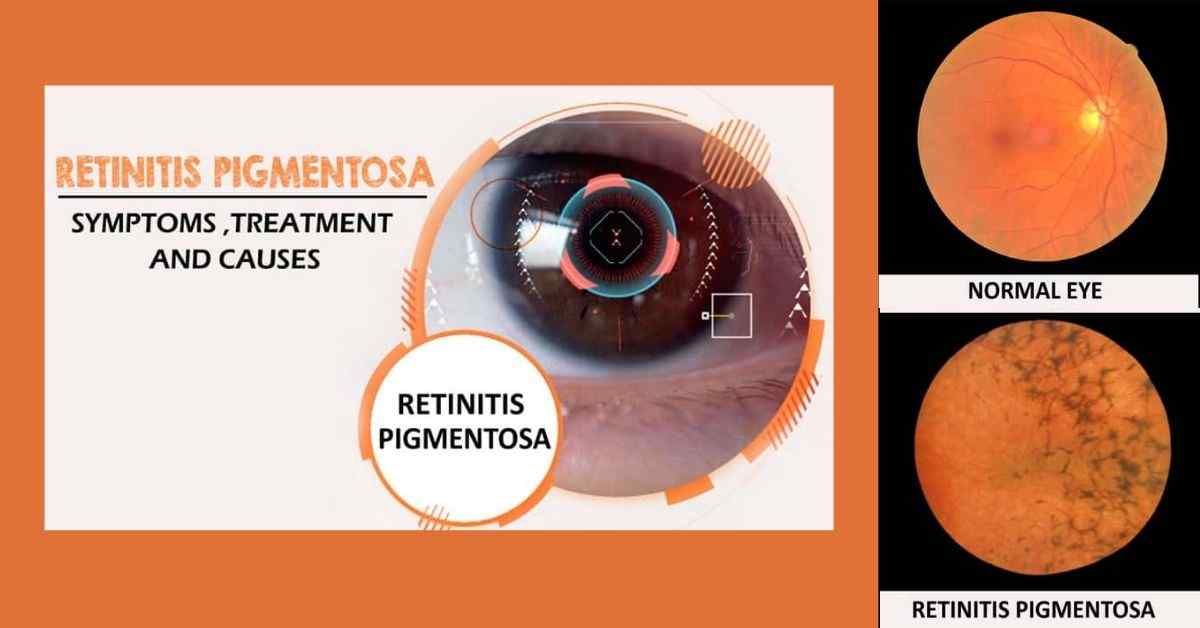Retinitis Pigmentosa is one of the rare hereditary eye diseases. In this article, we have covered all the information and common queries about retinitis pigmentosa treatment, symptoms, and causes.
Table of Contents
ToggleWhat is Retinitis Pigmentosa?
Retinitis pigmentosa is a disease related to the eyes in which the person gradually experienced the decline of eyesight due to degeneration of the retina.
Researchers considered it as hereditary eye disease because of the gene mutation which is not favorable for the sight.
Which Part Of The Eye Has An Impact By Retinitis Pigmentosa?
This disease usually affects the retina of the eye. The retina is the thin lining at the back of the eye which usually expose to light sensitivity. It converts light into electrical signals and transfers these signals to the brain to create a vision.
So this disease firstly causes the degeneration of the retina then ultimately the loss of sight.
Symptoms Of Retinitis Pigmentosa
There are various symptoms of Retinitis Pigmentosa which often appear in the childhood or adult stage.
But when these symptoms become visible and how fast they spread, it may vary from person to person.
Following are some symptoms of RP:
Night Blindness
When we talk about the symptoms of the retinitis pigmentosa then the first thing to consider is that whether it affects rods first or the cones.
Usually, this disease affects rods first. They are at the outer part of the retina and activate at dim light, and then the subsequent degeneration of rods causes night vision. Which ultimately results in affecting the color perception, visual acuity, and central vision.
So we can say that night blindness is the earliest symptom of retinitis pigmentosa. Which subsequently ends to complete blindness in most cases.
Color Disorder
If RP affects the cone earlier, then it hit the central vision and color disorder to suffer first. Which is rarely happened in RP.
In this scenario, a person feels inconvenience to differentiate in colors.
Sensation Of Twinkling Or Light Flashing
Flashes of light are normal if a person hits or rubs his eyes with his hands, in such cases flashes appear and fade quickly.
In contrast, if a person sees these flashes, light streaks, or shooting stars and it stays for a longer time then it may also be one of the symptoms of RP.
Gradual Decrease In Vision
As discussed earlier that a person suffering from Retinitis Pigmentosa feels difficulty at night to see. As the condition becomes worse it will also affect the vision at day.
So we can say that a patient faces a gradual decrease in peripheral vision.
What Is Tunnel Vision?
After the gradual loss of vision, RP moves to the advanced stage. A time comes when a person is unable to see through the sides of the eye. He is only able to see through the small central part of the eye straight ahead.
This scene is the same as a person seeing through a tunnel. That’s why this state is known as tunnel vision.
Causes Of Retinitis Pigmentosa
Genetic disorder is the main reason for retinitis pigmentosa. More than 60 different genes can cause different kinds of retinitis pigmentosa.
Parents usually transfer this disease to their offspring so it is a hereditary disease.
Researchers have reported many cases that don’t have any known history of this disease in the family. So we can say that there are many hidden causes of RP.
How Is Retinitis Pigmentosa Inherited?
Usually, there are three ways by which the parents pass on the disease to their children; these ways include
- Autosomal recessive RP
- Autosomal dominant RP
- X-Linked RP
Autosomal recessive RP:
Autosomal recessive RP means that each parent possesses one defected gene and one normal gene each.
So the child has two copies of a defective gene from each of the parents. As this disease require the two copy of a defected gene.
So there is a 25% chance of each child of the family being affected by this disease.
Autosomal dominant RP:
Second way of transferring this disease is autosomal dominant RP. In which, the parent transfers one defected gene to affect the respective child.
This gene in the parent usually has a 50% chance to have this disease in the child.
X-linked RP:
Lastly, the X-linked RP means that the mother is the carrier of this disease and has a 50% chance to pass on her children.
Generally, the women who possess this defective gene have no symptoms or mild ones.
But the males have severe symptoms whereas the father doesn’t pass this gene to his children.
These are the three ways by which parents transfer this disease to their children. Which affects their vision and causes permanent blindness.
Does Retinitis Pigmentosa Skip A Generation?
Researchers have observed that retinitis pigmentosa is not be dominating in every generation. It can skip the subsequent generation or generations.
Diagnosis Of Retinitis Pigmentosa
When it is about the diagnosis then the eye specialist can only have a sure answer about the retinitis pigmentosa.
The ophthalmologist arranges the detailed checkup by having different kinds of tests to diagnose this disease.
How Retinitis Pigmentosa Is Detected?
Specialists used the following special tests to diagnose this disease:
- Ophthalmoscope,
- Visual field test
- Electroretinogram
- Genetic test
Ophthalmoscope
In ophthalmoscope, the doctor usually puts the eye drops in the eyes of patients to make the pupil wider to have a clear and deep look of the retina.
Then he uses his handheld device to examine the back of the eye. If the retina possesses some sort of dark spots then it means there is retinitis pigmentosa to the patient.
Visual Field Test
In the visual field test instead of putting anything in the eyes there is a tabletop machine in which the respective person sets his or her eyes in the center of vision.
The objects and lights are shown in the machine. The particular person should press the button when he/she can see that object or light.
This determines how far the person can see and thus evaluating that either that person has retinitis pigmentosa or not.
Electroretinogram
Experts use this to diagnose the retinitis pigmentosa. In which a gold foil or contact lens is set to the retina and then by the help of that gold foil or contact lens it is evaluated that how much retina responds to the flashes of light and thus make a conclusion that whether the person has retinitis pigmentosa or not.
Genetic test
Lastly the genetic test included the testing of the DNA of the particular person which helps in determining that whether the DNA possesses the defective gene or not and it gives high accuracy in the results.
If any person in the family possesses this disease then all the members of the family have to come for screening as the chances of having this disease would be higher.
Treatment Of Retinitis Pigmentosa
There is no proper medication or surgery to cure retinitis pigmentosa permanently. But medical science is trying hard to diagnosis any cure or retina transplantation but yet not no permanent solution is available.
What Is The Best Treatment For Retinitis Pigmentosa?
- Acetazolamide
- Vitamin a palmitate
- Sunglasses
- Retinal implant
Acetazolamide
It helps in the later stage of retinitis pigmentosa. As then the tiny area in the center of the retina swell and ultimately causes loss of vision, this condition is called macular edema.
This sort of medication helps in easing the swelling within the retina and restores the sight by improving it.
Vitamin A palmitate
The second type of medication is vitamin A palmitate in which patients take high doses which slows down the procedure of retinitis pigmentosa a little every year.
But be careful while having the excess as it can be toxic. So the patient should have the doses as per the amount prescribed by the doctor.
Sunglasses
It sounds weird but it also helps in medication in the treatment of retinitis pigmentosa.
As it protects the eyes from more exposure to the light and the harmful ultraviolet rays that speed up the procedure of vision loss.
Retinal Implant
Ophthalmologists use this implant when the patient is at the later stage of retinitis pigmentosa as it provides partial sight to the patient.
In the US, Specialists use Argus II to implant one eye with the glasses. These glasses have an attached camera.
It helps the patient to locate lights and windows in the room. The camera takes images and converts them into electrical pulses.
Then these electrical pulses are sent to retia for further processing. Even there is the possibility that the patient can read the letters that are up to 9 inches high by this.
Is Vitamin E Bad In Retinitis Pigmentosa Treatment?
Keep one thing in mind that patients with retinitis pigmentosa should not have a supplement of vitamin E alone. As it can speed up the vision loss procedure in the disease.
Other treatments besides that include the replacement of damaged tissues or cells with the healthy ones in the retina or can apply gene therapy by putting healthy genes in the retina.
What Is The Average Life Of A Person With RP?
The intensity of symptoms can be varied as if the patient is taking no treatment of retinitis pigmentosa.
Then the symptoms can worsen and the average span of life would be 40 years.
If the particular person taking some treatment then it can help to restore the vision and the life expectancy may reach 80 years.
Can You Have RP In One Eye?
All over the globe total of 1.5 million people are experiencing this disease. Usually, all are facing this disorder cause of the effect of vision on both the eyes symmetrically but in some rare cases, one eye can be more effective than the other one.
Researchers are unable to find the actual reasons for this disorder that what causes this to influence one eye or both. Because it is purely due to variation in one gene mutation and hereditary by the X-linked genes.
Does Everyone With RP Go Blind?
This disease usually takes the vision of the affected person. The person may eventually go blind for the rest of his or her life. But if the question emerged that can legally blind drive.
Then the answer to it is usually the legally blind has the vision 20/200 i.e. the person vision can see up to 20 feet away.
Whereas generally, the normal vision person can see 200 feet away from the objects perfectly. So the low vision can affect significantly every matter of life.
At What Age Is RP Diagnosed?
Researchers considered that people with retinitis pigmentosa are usually completely blind till the age of 30. But many cases can retain useful vision till the age of 80 so it may vary.
The variation comes because of the intensity of the disease and it is no wonder if the significant variation happens among the patients of the same family.
Is RP The Same As Macular Degeneration?
Many eyes diseases end up to blindness for a particular person; retinitis pigmentosa and macular degeneration are among those sorts of diseases.
Both diseases are related to genetic mutation which further causes the degeneration of the part of the eye which results in loss of vision.
The difference is the retina pigmentosa relates to the degeneration of the rods. Whereas macular degeneration caused the degeneration of the cones.
Has RP Considered A Rare Hereditary Or A Common Disease?
The retinitis pigmentosa if happened once in the family then it can’t be stoppable. As genetically this disorder affects the genes from one generation to other.
This disease usually happened in every 1 person out of 4000. So the rate is lower but due to inheritance and issues in gene mutation, it is not curable and to date, no treatment can be discovered yet.
So it shows that RP is not a common disease, instead, it is a rare disease that transmits hereditary.
Can Females Get RP And In Whom It Is Most Common?
RP is most common in males. As we have discussed earlier that it is X-linked inheritance. So this disease doesn’t affect the females but they are the carriers.
Furthermore, the autosomal recessive type of retinitis pigmentosa may affect the person, without any known inheritance of this disease in their family.
Conclusion
There is no permanent treatment for the retinitis pigmentosa. At present but many researchers are trying to find out the cure. In recent years, stem cell therapy has made progress. But still, it has some limitations.
There is also trying to stop the defective gene to be dominant in the children, whose parents are carriers by arranging proper screening and genetic testing.
Many ways of medication are also in the pipeline to treat the retinitis pigmentosa permanently.

The latest research and updates straight to your inbox !
Join our subscribers for exclusive access to our monthly newsletter related to optometry






Pingback: Hereditary eye diseases that cause blindness - EyesOPT
Pingback: Retinitis Pigmentosa Support Group - EyesOPT
Pingback: What Does a Person With Retinitis Pigmentosa See?
Pingback: Natural Treatment For Retinitis Pigmentosa - EyesOPT